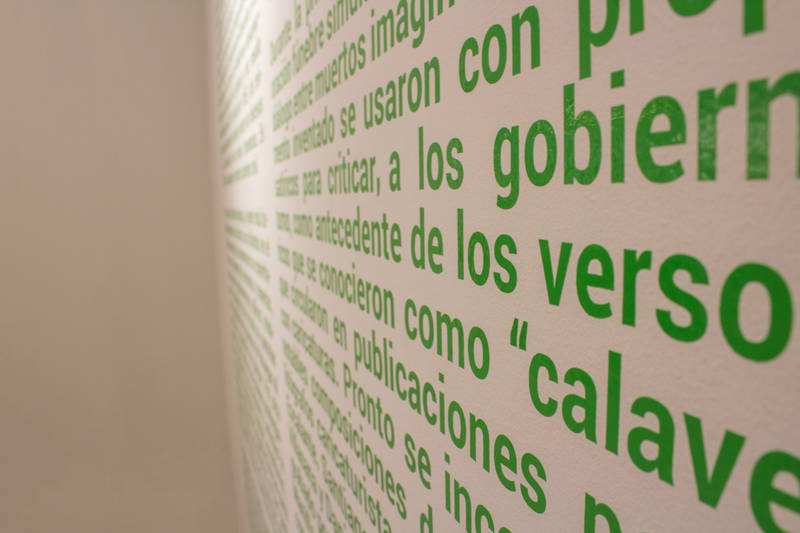Languages are constantly evolving to suit the needs of their speakers. The Spanish language, with its international community of speakers and long history of intercultural exchange, is no exception. Most often, a language expands when it comes into close contact with another language and begins to incorporate grammatical features and/or loan words from that language. Many English words, such as chocolate or barbeque (from barbacoa), came from interaction with the Spanish language, which had adopted these terms from indigenous languages of the newly “discovered” Americas. The most notable trend of vocabulary growth in present-day Spanish is due to loan words from English, especially in the technical domain. This dynamic nature of language is what makes determining the word count for a language a very complex task.
What counts as a “word?”
The space between
The most intuitive condition is that a word is what is separated by spaces in a language such as English or Spanish which uses an alphabet to create words (rather than characters). However, what about open compound words such as “ice cream?” Certainly, as Aristotle said, “the whole is greater than the sum of its parts.”
Dictionary entries
With the above example in mind, an easy way to decide if something is one “word” is to check to see if it has its own dictionary entry. After all, there are people dedicated to maintaining dictionaries for just this reason, right? Though a language often has a few prominent dictionaries that are considered official, word counts often differ between these and diverge even further when compared with glossaries. Dictionaries even acknowledge the difficulty in pinning down a definitive count. Merriam Webster states that although they estimate the total count of English words (including technical acronyms, Latin species names, etc.) to be around 1 million, this number may be off by up to a quarter million.
Despite this, dictionaries are still a great starting place for sorting out individual words which have unique meanings attached to them. According to this condition, we would expect plural forms of words to be counted as one word (such as “bunny” and “bunnies”), as they are tied to one definition. This would also extend to conjugations of verbs, meaning that an infinitive verb and all of its conjugations, irregular or not, would count solely as one word. If you’ve ever taken a look at a Spanish conjugation table, you know that whether or not you count the inflected forms of a verb will seriously impact your final word count. For example, the verb estar (“to be”) has nearly 100 different forms, depending on who is being addressed and when the action takes place.
Urban Dictionary
Even the most in-the-know among us have resorted to looking up the slang usage of a word or phrase in the Urban Dictionary. The most culturally relevant entries (such as hangry) generally make their way into the more official dictionaries, but what about the rest?
Some words may be tied to a specific community of speakers based on their region, age group, or common hobbies. Many multi-player cooperative video games allow microphone usage, meaning that certain gaming slang may be shared by speakers of a language across the globe. Though these words may never be relevant enough to popular society to make it into a dictionary, they are still used by native speakers and may even be shared by people with otherwise divergent regional dialects.
Which words to include
Whether or not to include all wordforms of a word (for example, the singular and plural form of a word) depends on the purpose of such a list. If you need a word list to feed an algorithm that powers the speech-to-text function of your phone, you probably want each of these distinct wordforms included. If you’re making a vocabulary list to learn a language, you may prefer a more network-like description which allows you to learn related wordforms, such as the conjugations for a specific verb.
So, as a Spanish learner, the most relevant questions to ask are:
- What is a widely accepted estimate of the number of words in Spanish?
- How many words do I need to be familiar with to be conversationally fluent?

Science says there’s a faster way to learn Spanish
Diccionario Real Academia Española: 93,000 words
The Diccionario Real Academia Española is managed by the Royal Spanish Academy in Spain. It is one of the most commonly cited “official” sources of the Spanish language. When they “accept” a word, it means it has fulfilled their criteria, similar to how words are generally considered “official” when they’re accepted into the Oxford English Dictionary (British English) or Webster-Merriam Dictionary (American English). The most recent edition of the dictionary was published in 2014 and includes more than 93,000 entries, including americanismos from Spanish spoken in the Americas. If you’re a native English speaker, you can compare this with Oxford English Dictionary’s reported 171,476 words in current use.
Fluency for Spanish learners
Some research suggests that learning approximately 2,000 words allows language learners to be competent in reading 80% of a given text. Written language generally employs more diverse vocabulary and complex sentences than spoken language, but it has the advantage of allowing you to deduce meaning from context clues and more clearly see verb conjugations. Spoken Spanish is usually much simpler, meaning that learning 2,000 of the most frequent Spanish words will get you pretty far in a spoken conversation.
Once again, your personal goals for learning a language will affect your idea of “fluency.” Domain-specific words such as medical jargon or video gaming slang may be areas that you want to prioritize, or perhaps you plan to take a general placement exam, such as the Common European Framework for Languages Spanish exam. You can check your current level using this free Spanish proficiency test.
When asked about the amount of words necessary to feel “fluent,” polyglot and linguist Dr. Alexander Arguelles created this helpful breakdown in a post on a well-known language learning forum:
- 250 words constitute the essential core of a language, those without which you cannot construct any sentence.
- 750 words constitute those that are used every single day by every person who speaks the language.
- 2,500 words constitute those that should enable you to express everything you could possibly want to say, albeit often via awkward circumlocutions.
- 5,000 words constitute the active vocabulary of native speakers without higher education.
- 10,000 words constitute the active vocabulary of native speakers with higher education.
- 20,000 words constitute what you need to recognize passively in order to read, understand, and enjoy a work of literature, such as a novel by a notable author.
Which words to study?
Part of the beauty of learning a language is that you’ll never really be finished. Language is a miraculous system, because, as early linguist Willhelm von Humboldt posited, it “makes infinite use of finite means.” This defining feature of language means that we are able to spontaneously create brand new sentences that have never before been uttered from a finite alphabet. What makes learning Spanish so exciting is that you will continue to discover new words, some of which may be so regional or so new that they aren’t defined anywhere in a dictionary!
If you’re just starting out with Spanish, it is best, of course, to begin with the most frequently used words. Depending on where you plan to use your Spanish the most, Lingvist’s online Spanish course allows you to select either Neutral or American Spanish. These most necessary words are organized into levels in Lingvist’s Spanish course, with one level representing about 100 new words. Lingvist uses the half a billion learning events from its learners as data points to calibrate its courses. This means that the courses provide the most efficient balance of support for statistically challenging words and predictions for future learning based on a user’s individual performance.
With the advantage of artificial intelligence to track your progress, Lingvist allows you to maximize your learning time by providing you with the opportunity to practice words that you haven’t mastered while leaving out those you’ve already shown that you know well. Lingvist also employs techniques gleaned from memory and retention research, such as spaced repetition, which takes into account the “decay” of words in your memory over time that haven’t been practiced recently. According to learning data analyzed by Lingvist’s data scientists, it usually takes a learner about 17 hours to learn the 2,000 words needed to feel comfortable in a conversation.

Start speaking Spanish fluently, fast.
What’s the best way to acquire new vocabulary?
Lingvist uses a mixture of direct memorization and in-context exposure to vocabulary, which may come as a surprise to those accustomed to learning large vocabulary lists through flashcards or rote memorization. Though learning vocabulary within the context of conversations or text may not feel at first as productive as memorizing word lists, long-term retention is greatly improved when your memory has additional context to trigger recall.
Just like studying animal behavior in the wild versus in a lab, additional invaluable information is only accessible through studying words within their naturally occurring “habitat.” For example, though a word like “large” may be a synonym to the word “big,” only one of them will sound natural to a native speaker when placed in front of “mistake.” The words that a given word traditionally occurs next to are called collocates. The best way to become aware of these kinds of implicit rules is exposure to vocabulary words in context.
Ready to start increasing your vocabulary? Try Lingvist’s newly expanded Spanish course – now with more than 5,000 words!




